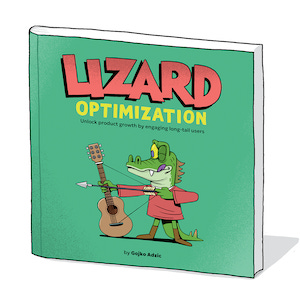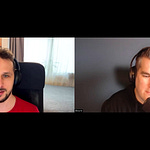Welcome to the next week!
My favorite conspiracy theory is that the stuff we make in software actually has any sense.
That's a big conspiracy, and you can see people believing that, and that's just not true.
I mean, it is in some percentage, but a very, very small percentage.
As you see, we started strong in this week’s episode. That’s a quote from Gojko Adzic, our very special guest. We discussed a special technique created by Gojko: Lizard Optimization.
Understanding product development for technical people is important to me, so I’ve decided to open it for everyone so you can watch it without a paywall.
I’m a fan of his works, so I’m happy he accepted my invitation. He’s the author of the collaborative technique Impact Mapping, and wrote 9 books, including Specification by Example and products builder. I like his approach to joining hands-on developers and his mechanical-friendly approach to building IT systems that matter. On my own, I was part of multiple projects that had good architecture and great teams but still failed because the product decisions were wrong and our approach was not aligned.
Still, moving to the Lizard Optimization.
Lizard Optimization is a technique for improving product development by focusing on long-tail users who seem to follow unpredictable, “lizard-like” logic. The term comes from the idea that these users often behave unexpectedly, much like a lizard’s erratic movements, which don’t fit typical patterns. Engaging these users can provide fresh insights into your audience and help you refine your product.
Gojko developed this method after managing a software product that experienced rapid growth from November 2021 to November 2022, with a critical user metric increasing over 500 times. This turnaround followed a period of stagnation, and it was driven by an unconventional approach to engaging these unpredictable, “lizard-like” users.
At the end of our discussion, Gojko surprised me by offering a generous 50% book discount link, especially for you, an Architecture Weekly subscriber.
You can get it here: https://leanpub.com/lizardoptimization/c/i12lFE3oPrg9.
Highly recommended, 4.99$ for a good book? Easy choice.
I’ve read the book and enjoyed it. As with each of Gojko’s works, it’s an easy and funny read but also filled with practical guidance. The approach fits more with products and users, so we can track their weird behaviours. Still, you’ll find many additional materials to the complementary techniques that Gojko recommends.
Some of those that we touched upon during discussions are:
Trustworthy Online Controlled Experiments by Ron Kohavi
Evidence-Guided: Creating High Impact Products in the Face of Uncertainty by Itamar Gilad
Experimentation Growth Model by Aleksander Fabijan
One of the technical foundations for being able to be able to experiment with the product is to gather data on the failures or unexpected behaviours. So making it observable. We touched on that in the last editions:
And we’ll continue on that!
Check also the episode with Michael Drogalis on Building the product on your own terms. It should be a complementary source for people who are (thinking of) bootstrapping their own products.
What are your thoughts and experiences?
Check also other webinars!
Cheers!
Oskar
Webinars:
#2 - Keep your streams short! Or how to model Event-Sourced systems efficiently
#6 - Alexey Zimarev - You don't need an Event Sourcing framework. Or do you?
#7 - Design and test Event-Driven projections and read models
#9 - Radek Maziarka - Modularization with Event Storming Process Level
#11 - Maciej "MJ" Jędrzejewski - Evolutionary Architecture: The What. The Why. The How.
#12 - Jeremy D. Miller: Simplify your architecture with Wolverine
#14 - Mateusz Jendza: Why Verified Credentials is the Future of Digital Identity!
#15 - Mário Bittencourt: Leveraging BPMN for Seamless Team Collaboration in Software Development
#16 - Papers We Love #1 - Sagas (Hector Garcia-Molina, Kenneth Salem)
#18 - Andrea Magnorsky: Introducing Bytesize Architecture Sessions!
#20 - Papers We Love #2 - How do committees invent? (Melvin E. Conway)
#21 - Michael Drogalis: Building the product on your own terms
#23 - Gojko Adzic on designing product development experiments with Lizard Optimization













